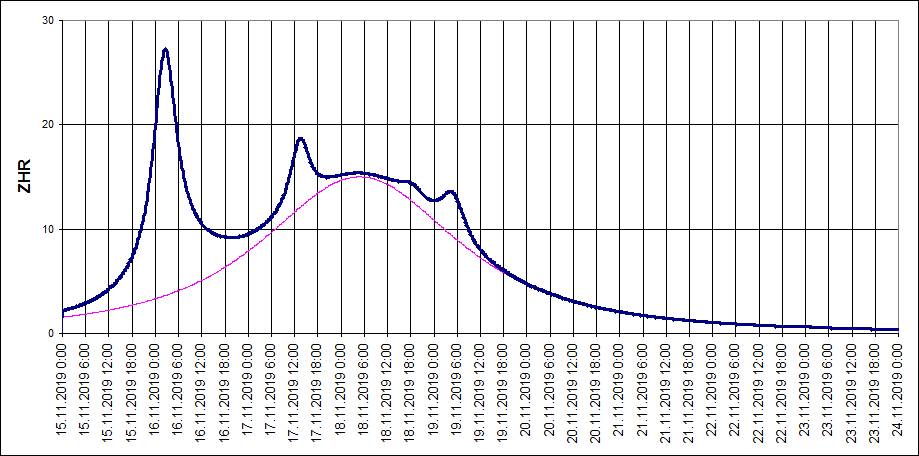In 2019 the Leonids could produce some activity enhancements in addition to the background maximum. Potentialy the most interesing one is a quite prominent peak with expected ZHR=27, it is connected with 1400 trail, its computed maximum time is at 2:35 UT on 16 November, which is two days before the background maximum. However the reliablity of this ouburst predition is quite low, as the Earth enconters the part of 1400 trail composed of particles with negative ejection velocities (around -16 m/s). Such trails parts are depleted with particles as smaller of them are blown out by radiation pressure. Nevertheless we suggest that some remaining larger particles could pruduce a notable activity enhancement with high share of bright meteors.

Fig. 1. Assumed profile of overall Leonid activity (blue line) and its background component (red line).
As shown on the Fig. 1, the background maximum itself interlapses with a number of small outbursts from trails. For instance, at 13:35 UT on 17 November a small enhancement is possible with ZHR=6-7 above the background (total ZHR=19). Prediction of this enhancement is much more reliable as it is caused by encounter with 1866 trail composed of particles with positive, though very high (93 m/s) ejection velocities. It means small sizes of particles, so faint meteor share could increase at the given maximum time. Also the number of radiometeors could significantly increase.
The third small activity enhanced is visible on the Fig. 2 after the background maximum, its computed peaktime is 4:13 UT on 19 November, and its own ZHR=4 while together with background activity total ZHR=14. This enhancement is connected with 1800, but, as the first one, with particles ejected with high negative ejection velocity of -26 m/s, which makes the reliability of this enhancement prediction very low.
For some additional information proceed to http://feraj.ru/Radiants/Predictions/Leonids2019eng.html
References
1. “Comet’s dust 2.0” program by S. Shanov and S. Dubrovsky. [Used for orbital computations.]
2. Lyytinen E, van Flandern T. “Predicting the strength of Leonid outbursts”, 2000, Earth, Moon and Planets, P. 149-166.
3. Jenniskens P. Meteor showers and their parent comets, 2006, 780 p.
4. Kasuo Kinoshita, http://jcometobs.web.fc2.com/ [Orbital elements of the comet 55P/Tempel-Tuttle]


Very interesting article. I saw the 1998 storm. I’ll keep a watch on meteor activity with videography and on Graves radio transmissions received at Loughborough by FCD.